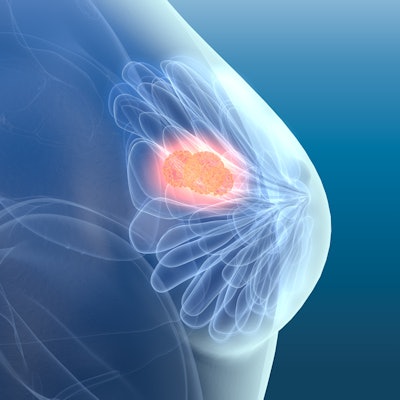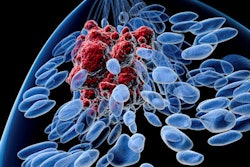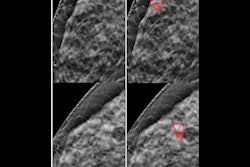
The combination of breast density and artificial intelligence (AI)-based analysis may be able to significantly reduce the number of interval cancers missed in mammography screening programs, Dutch researchers reported in a Thursday presentation at ECR 2021.
In a large retrospective study that included nearly 2,500 cases of interval cancer, the researchers found that a risk model that integrates an AI cancer likelihood score with quantitative breast density analysis was able to identify more than half of all interval cancers on prior negative screening mammograms.
"[The combined risk model] can be used, I think, as a supplement to current breast cancer screening programs by defining which women could benefit from additional evaluation," said presenter Dr. Jan-Kees van Rooden, PhD, of Haga Teaching Hospital in The Hague.
Although screening with digital mammography has reduced breast cancer mortality, up to half of interval cancers and large screening-detected cancers are visible in retrospect on the previous screening round, according to Van Rooden. In addition, screening mammography has limited benefit in women with dense breasts.
As a result, the Dutch team sought to create and evaluate a breast cancer risk model that combines the results of an AI detection system with quantitative breast density analysis to assess the risk of subsequent interval cancers. They first retrospectively gathered the prior mammograms and patient data for 2,342 cases of proven interval cancers found between 2011 and 2015. The median time from the last negative screening mammogram until diagnosis of interval cancer was 15 months.
The researchers then applied the Transpara AI software (ScreenPoint Medical) to all of these prior mammograms, as well as 4,684 normal exams that were matched by age and year of diagnosis to the interval cancer cases. In addition, breast density was automatically computed on the exams using the publicly available Laboratory for Individualized Breast Radiodensity Assessment (LIBRA) automated breast density estimation software developed by the University of Pennsylvania.
Finally, they developed a neural network-based model that combined the breast density analysis results with Transpara's AI Exam Score, which is calculated on a scale of one to 10, representing an increasing likelihood of cancer. The combined model was trained using tenfold cross-validation.
Although the AI software flagged 37.5% of the interval cancers with its highest score, the best performance was achieved by the combined risk model, according to the researchers.
| Performance of Transpara AI for quantifying short-term risk of interval cancer | |||
| Breast density analysis | AI model | Risk model combining AI and density analysis | |
| Area under the curve (AUC) | 0.691 | 0.733 | 0.793 |
| Sensitivity (at 90% specificity setting) | 22.4% | 37.5% | 50.9% |
Delving further into the results, the researchers found that the combined risk model had an AUC of 0.762 for detecting ductal carcinoma in situ (DCIS) and 0.794 for invasive cancers.
In addition, the combined risk model had an AUC of 0.836 for detecting interval cancers found zero to 12 months later, an AUC of 0.769 for interval cancers found 12 to 24 months later, and an AUC of 0.698 for interval cancers identified 24 to 36 months later.



















